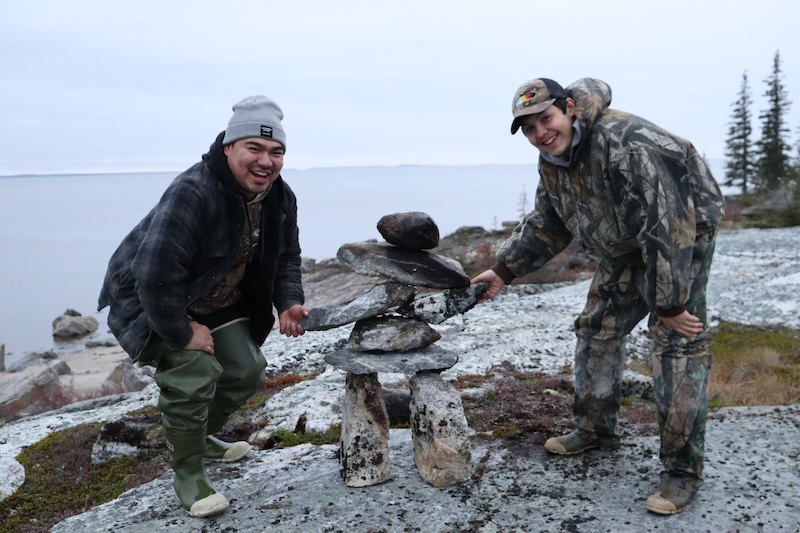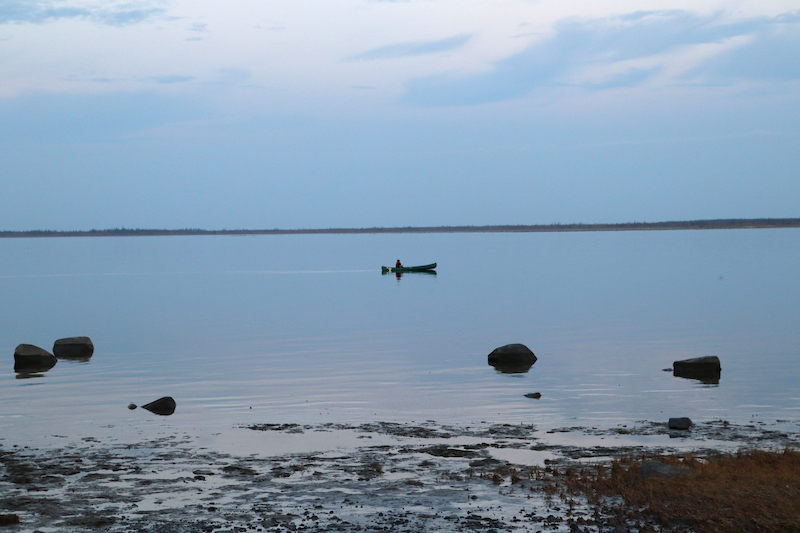A new program long wished for by the Cree Trappers’ Association (CTA) started in Waskaganish on September 27 called Eeyou Ituun (Cree Land Stewardship), which aims to teach fundamental bush skills and traditional knowledge to younger generations.
Since 2014, the CTA has been working with Niskamoon Corporation and the Cégep de St-Félicien to establish this 900-hour accredited program. Open to all Cree registered under the JBNQA who are 18 or over, graduates of the Land Stewardship program will earn an Attestation of College Studies certificate from the Cégep at a ceremony following completion in March.
“Our goal is to have the students learn what it was like in the old days when you survived on the land,” said Mary Jane Salt, Eeyou Ituun coordinator. “They have to find their own food and learn the traditional skills so they can pass them on to others and maintain our traditional way of life.”
While the program was initially planned to begin in March 2020, it was delayed several times before a two-week pilot project was launched last winter to finalize preparation. Now a total of 17 students from across Eeyou Istchee are enrolled, ranging in age from teens to mid-40s.

“They all have different reasons for applying to the program,” Salt told the Nation. “Many said they like being out on the land, ‘it helps me a lot’ or ‘I want to learn so I can pass it on to my children.’ Some are the next tallymen so they want to know.”
Several of the 15 competencies covered in the program are essential skills for managing natural resources on family traplines, such as territory surveillance, wildlife monitoring and land use negotiation. Each of the program’s three sessions feature extensive stretches of autonomous camping on the land to maximize the various learning opportunities presented in each season.
After an orientation day at the Waskaganish lodge, the group headed out to Km 18 where they learned to build a camp from scratch. With the guidance of four instructors, the students built a teepee and shaptuan while participating in harvesting activities over nine days.
“We wanted them to experience how it feels to build a camp out on the land,” Salt explained. “Some slept in the shaptuan. They did harvesting of beaver. They were donated a full bear and did all the skinning and the preparation that needs to be done. They also did gill netting and learned how to cut fish.”

“We wanted them to experience how it feels to build a camp out on the land,” Salt explained. “Some slept in the shaptuan. They did harvesting of beaver. They were donated a full bear and did all the skinning and the preparation that needs to be done. They also did gill netting and learned how to cut fish.”
After this experience, the group headed to a camp called Siisiijiinuk along the Jack River. It was a beautiful day for travelling out on the bay as the students prepared to apply the knowledge they had learned so far for a more self-sufficient excursion.
“The first week was camp with support,” said Salt. “When they went to the Jack River, it’s called Camp Autonomy. We told them whatever food you take, you must try to stretch it over the whole week. Whatever is harvested, you eat what you prepared. It was like in the old days when you had to survive on your own.”
Adapting to this way of life isn’t always easy for those accustomed to familiar foods and the comforts of home. Salt and her team regularly give the students encouragement, reminding them about the program’s goals and reassuring them that they’re with a supportive group of Crees. She says this is less challenging than the culture shock often experienced when navigating studies in the south.
“At the beginning of the program, it was difficult for them to adjust,” Salt shared. “It was hard for us to encourage them to eat what they had over there. Some said I don’t eat that. They did much better at the second camp. I didn’t have any complaints.”
It has been a character-and-team-building exercise for the students to come together in this way, performing all aspects of meeting their basic needs as they learn about themselves and the land. A few of the students who don’t speak Cree have had additional challenges learning important words and expressions.
“There are days they’re homesick,” said Salt. “I always ask them how they feel – I know they’re anxious to go home sometimes. Some out-of-town students have relatives in the community and they have probably made new friends. I know some have girlfriends already.”
After classroom time at Waskaganish’s Rupert Hall, learning how to make snowshoes and other tool crafting, there is a one-week break before the second session begins with bush-kit training. On November 22, they’re scheduled to go out on the land near Km 298 of the Billy Diamond Highway for three weeks, again camping independently following some initial support.
Then it’s a four-week break over the Christmas holidays before more class time and winter camping at a location that hasn’t yet been confirmed. With special emphasis on land-user safety and nurturing an appreciation for environmental sustainability, the program greatly benefits from the expertise of numerous Cree Elders who participate in various stages of the students’ journeys.
There is no cost to join the program and students are provided allowances and meal monies from Apatisiiwin Skills Development to buy their own groceries. Community members are compensated for welcoming out-of-town students into their homes. Additional program funding comes from the Cree Nation Government’s social and cultural department, Plan Nord, Cégep de St-Félicien, Canada’s Challenge Fund, and the regional CTA.
The inaugural edition of the Cree Land Stewardship program is proving to be a learning experience for both students and organizers. While Waskaganish was chosen as this year’s base primarily because it is Salt’s home community and she is more familiar with the camps, tallymen and instructors, the program is intended to move to a different Cree community next year.
Although 900 hours isn’t enough to learn everything about Cree culture, the valuable skills learned by program participants are excellent preparation for future tallymen or wildlife protection assistants in Eeyou Istchee. Interested students who missed this year’s deadline can learn more about the program in a forthcoming series from a video documentary crew who have been accompanying the group throughout their adventures.
“Our plan is to release the first session documentary,” said Salt. “They’re filming and doing interviews with the students. At the beginning, the students didn’t know who they were. It was challenging going to school with someone they don’t know. Today I see a lot of change.”





